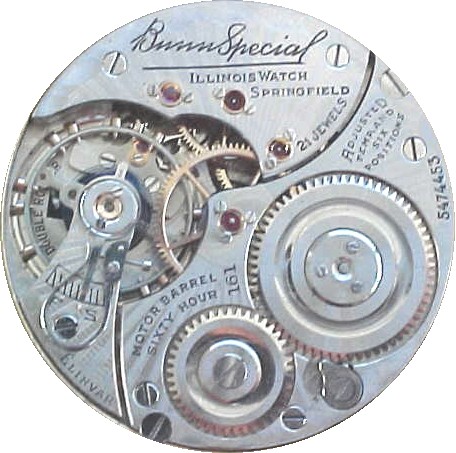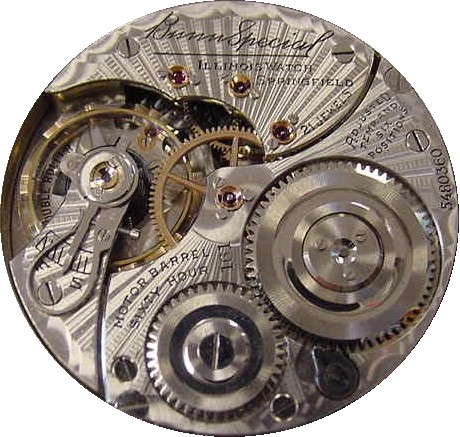
| WWT Shows | CLICK TO: Join and Support Internet Horology Club 185™ | IHC185™ Forums |

|
• Check Out Our... • • TWO Book Offer! • |
Welcome Aboard IHC185™  Internet Horology Club 185
Internet Horology Club 185  IHC185™ Discussion Site Main Page
IHC185™ Discussion Site Main Page  Open to the World RESEARCH FORUMS
Open to the World RESEARCH FORUMS  Illinois Watch Company Research Forum
Illinois Watch Company Research Forum  161-Mystery?
161-Mystery?
 Internet Horology Club 185
Internet Horology Club 185  IHC185™ Discussion Site Main Page
IHC185™ Discussion Site Main Page  Open to the World RESEARCH FORUMS
Open to the World RESEARCH FORUMS  Illinois Watch Company Research Forum
Illinois Watch Company Research Forum  161-Mystery?
161-Mystery?Go  | New Topic  | Find-Or-Search  | Notify  | Tools  | Reply to Post  |  |
Don't see a problem here Peter, just another example found, that contradicts the book databases or CDs. It is examples like this that lets us clean up inaccuracies in the data. Watches were not finished in serial # sequence, and yours more than likely was finished earlier than others in that serial # range. Charlie | ||||
| IHC President Life Member |
This watch in our Chapter 185 Mart with these words... "Movement serial number 5474454 is a Type II total production is 2,033" No mystery, described as exactly what it is, a 161 Type II which is before the Type II Elinvar variant. As we explained recently when an eBay seller claimed to have an "un-marked 163" the movement "Type" designations for these watches were devised by the late Bill Meggers, always remember they are not a reference that was used by the manufacturer. As this situation clearly points out the manufacturer did not keep track of exactly where different variants within the runs would have been separated. What Peter is finding can be frustrating, many of the runs were in fact mixed runs with more than one "Type" of movement and it proves beyond a doubt they were not necessarily finished in chronological order. This really is not at all unusual and as Charlie pointed out above information such as this helps those who track the movement numbers to narrow things down. Once again we see that all these details we so obsess over today meant little if anything to the people who made and marketed these watches some seventy-five years ago. I am sure they would be amazed to find not only that so many of their watches survived but that they mean so much to so many of us. This is a great hobby, it's fun learning something new every day. | |||
Well.... you've settled it! I'm posting a picture of a movement that is the "twin" of my movement, the consecutive serial number. We've been talking about reuniting "twins" recently on this list (Lindell has a consecutive pair of South Bend watches). Well.... here are consecutive serial Illinois movements, from the middle of the same run..... that are NOT even of the same grade! Will this hobby ever stop surprising me?  | ||||
Before anyone gets the wrong idea. I am NOT dissastisfied, in any way, with this watch or with the seller. I have checked it and the movement appears to be absolutely original. If anything... I am thrilled with the mystery and the explanation. If it doesn't add monetary value to the watch.... it sure added to my enjoyment. Now.... who wants to sell me that 161E "twin?" | ||||
| IHC President Life Member |
Yes, not only is this very interesting, this is what makes for a lot of fun! Another point is driven home by the fact Peter's movement is 5474454 yet 5474453 which conventional wisdom would say is an earlier movement clearly was not. We have often found the watch companies did not necessarily finish movements in chronological order. In reality, there could be and often were long periods of time elapse between when movements that we would think should be closely related were actually finished. In this instance, the two movements in question, 5474454 (non-Elinvar) and 547453 (Elinvar) are the opposite of what some present day observers might expect. This illustrates why we should not say that a change occurred at or immediately after one particular movement number but rather that it occurred around or near a certain number. There is so very much we may never really know for certain. And as Peter pointed out, what an "odd-couple" those two watches would be! | |||
The plot thickens, Lindell. Look at this! Here is SN 5480360, almost 6000 numbers away, and it is clearly a 161 NON-ELINVAR (Balance cock not marked... bimettalic balance). I think this illustrates exactly what you were saying. This was all in 1931 and the model changes were not "complete" when the manufacturer brought out his new model. If the customer wanted a 161... that's what he got. Sales were too important. We also need to know something about the manufacturing process. The balance cocks were engraved "Elinvar" (or not) and the SN was stamped on the back. This indicates, to me, that one of those procedures was done quite late in the manufacturing process. For instance, did the assemblers sit in front of two boxes of balance cocks, either marked "Elinvar" or not? Then, when the orders came in, they merely chose the right one, stamped the SN on the back and attached either an Elinvar or Non-Elinvar balance complete?  | ||||
| IHC President Life Member |
I don't think it is that simple, and like I said above... "We have often found the watch companies did not necessarily finish movements in chronological order. In reality, there could be and often were long periods of time elapse between when movements that we would think should be closely related were actually finished." That's some of what you are finding and of course we must consider the fact we are aware there was some buying resistance to "Elinvar" among some retailers. Perhaps there were a few orders for non-Elinvar movements or they were just using up left-over parts which to me seems more likely. We can speculate about such things but in the absence of factory documentation that's all any of us can do, we're speculating, making guesses based upon logic, what we know to be common watch company practices along with what we find before us. In the depths of The Depression they did whatever it took to try and stay in business. | |||
What we'd give to be a "fly on the wall" at the Illinois factory in 1931! Your point is well taken. The companies did not think about their watches as we do. Case in point. My Dad owned a display business in Chicago. From WWII until its virtual demise, one of his biggest customers was Elgin Watch Co. He made window and counter displays that usually were part of a seasonal promotion. (Before you ask, I don't have a single example of those.) He MAY have toured the Elgin plant once or twice, but I can assure you that he knew absolutely nothing about watches and could care less. He dealt only with the Advertising and Art Departments. When we see assembled watches in advertisements, they may well have been selected by folks who simply thought they looked good or would sell well. I think there was a huge gulf between the technical end of the company and the marketing end. | ||||
| Powered by Social Strata |
| Your request is being processed... |
|
©2002-2025 Internet Horology Club 185™ - Lindell V. Riddle President - All Rights Reserved Worldwide

